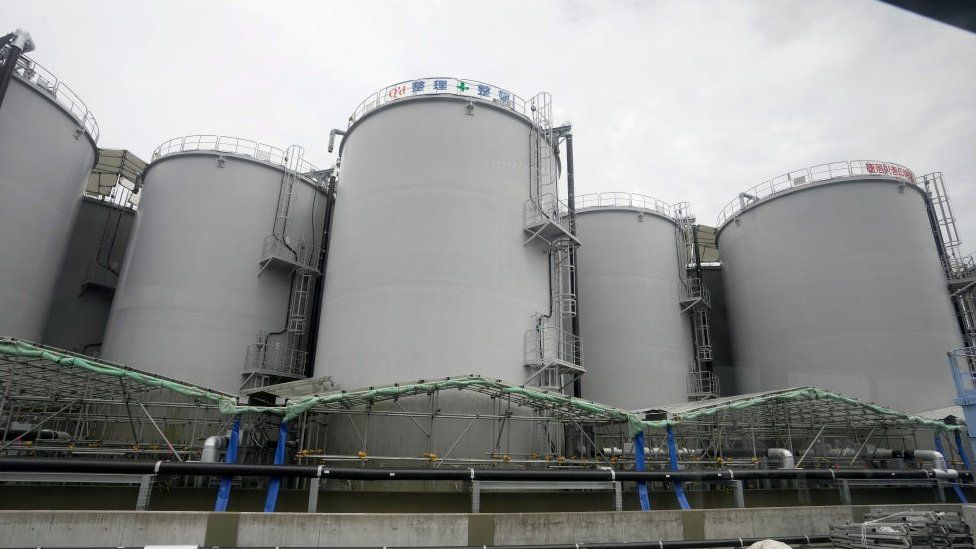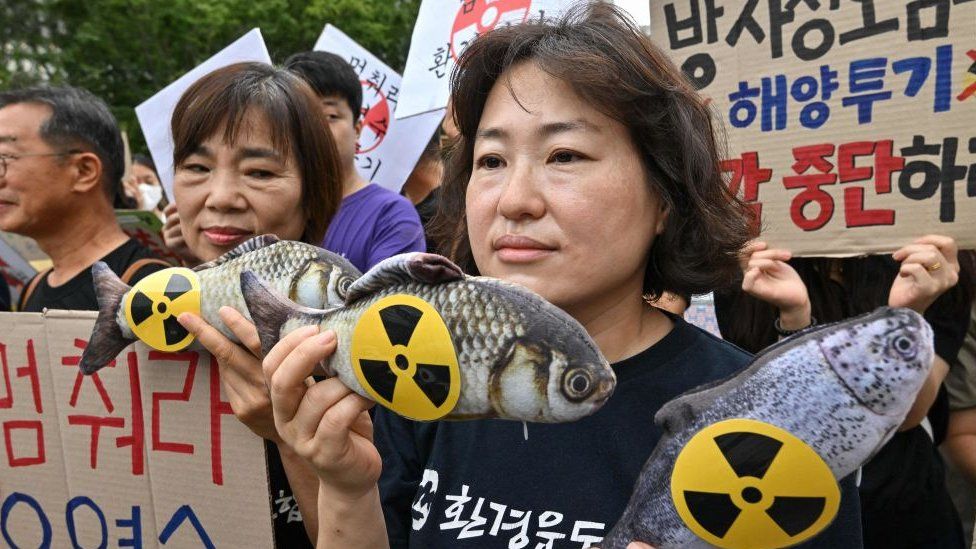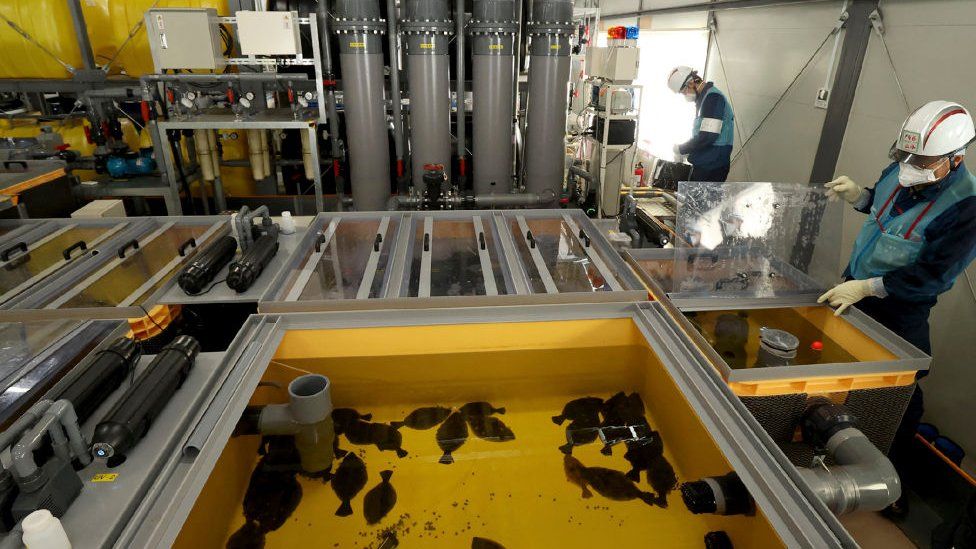UPDATES
The science behind the Fukushima waste water release
 GETTY IMAGES
GETTY IMAGESJapan has begun releasing treated radioactive water from its damaged Fukushima power plant into the Pacific Ocean - 12 years after a nuclear meltdown.
That's despite China slapping a ban on Japanese seafood and protests in Japan itself and South Korea.
The UN's atomic regulator says the water will have "negligible" radiological impact on people and the environment.
But is it safe?
An earthquake followed by a tsunami in 2011 wrecked the nuclear power plant, destroying its cooling system and causing reactor cores to overheat and contaminate water within the facility with highly radioactive material.
Since the disaster, power plant company Tepco has been pumping in water to cool down the reactors' fuel rods. This means every day the plant produces contaminated water, which is stored in more than 1,000 tanks, enough to fill more than 500 Olympic swimming pools.
Japan says it needs the land occupied by the tanks to build new facilities to safely decommission the plant. It has also raised concerns about the consequences if the tanks were to collapse in a natural disaster.
Japan is releasing the waste water into the ocean gradually, with a green light from the International Atomic Energy Agency (IAEA). The first release is one of four, scheduled between now and the end of March 2024. The entire process will take at least 30 years.
If Japan was able to remove all radioactive elements from the waste water before piping it into the ocean, perhaps it would not have been so controversial.
The problem is being caused by a radioactive element of hydrogen called tritium, which can't be removed from the contaminated water because there is no technology to do it. Instead, the water is diluted.
 GETTY IMAGES
GETTY IMAGESThe message from experts is, overwhelmingly, that the release is safe - but not all scientists agree on the impact it will have.
Tritium can be found in water all over the world. Many scientists argue if levels of tritium are low, the impact is minimal.
But critics say more studies on how it could affect the ocean bed, marine life and humans are required.
The IAEA, which has a permanent office at Fukushima, said an "independent, on-site analysis" had shown that the tritium concentration in the water discharged was "far below the operational limit of 1,500 becquerels per litre (Bg/L)".
That limit is six times less than the World Health Organization's limit for drinking water, which is at 10,000 Bg/L.
On Friday, Tepco said seawater samples taken on Thursday afternoon showed radioactivity levels were well within safe limits, with a tritium concentration below 1,500 bq/L.
Japan's environment ministry said it had also collected seawater samples from 11 different locations on Friday and would release the results on Sunday.
James Smith, professor of environment and geological sciences with Portsmouth University, said that "in theory, you could drink this water", because the waste water is already treated when it is stored and then diluted.
And physicist David Bailey, who runs a French laboratory measuring radioactivity, agreed, adding: "The key thing is how much tritium is there.
"At such levels, there is no issue with marine species, unless we see a severe decline in fish population, for instance," he said.
But some scientists say we cannot predict the impact of releasing the water.
American professor Emily Hammond, an expert in energy and environmental law with George Washington University, said: "The challenge with radionuclides (such as tritium) is that they present a question that science cannot fully answer; that is, at very low levels of exposure, what can be counted as 'safe'?
"One can have a lot of faith in the IAEA's work while still recognising that compliance with standards does not mean that there are 'zero' environmental or human consequences attributed to the decision."
 GETTY IMAGES
GETTY IMAGESThe US National Association of Marine Laboratories released a statement in December 2022 saying it was not convinced by Japan's data.
And marine biologist Robert Richmond, from the University of Hawaii, told the BBC: "We've seen an inadequate radiological, ecological impact assessment that makes us very concerned that Japan would not only be unable to detect what's getting into the water, sediment and organisms, but if it does, there is no recourse to remove it... there's no way to get the genie back in the bottle."
Environmental groups such as Greenpeace go further, referring to a paper published by scientists at the University of South Carolina in April 2023.
Shaun Burnie, a senior nuclear specialist with Greenpeace East Asia, says tritium can have "direct negative effects" on plants and animals if ingested, including "reduced fertility" and "damage to cell structures, including DNA".
China has banned Japanese seafood as a result of the waste water release. Some media commentators believe this could be a political move, especially as experts say there is no scientific evidence backing concerns around seafood, as the radiation released is so low.
But many people who are exposed to the Pacific Ocean every day have concerns.
Traditional female divers in South Korea, known as "haenyeo", tell the BBC they are anxious.
"Now I feel it's unsafe to dive in," says Kim Eun-ah, who has been doing the job off Jeju Island for six years. "We consider ourselves as part of the sea because we immerse ourselves in the water with our own bodies," she explains.
 GETTY IMAGES
GETTY IMAGESExperts say the waste water could be carried by ocean currents, particularly the cross-Pacific Kuroshio current.
And fishermen have told the BBC they fear their reputation has been permanently damaged and worry for their jobs.
The Pacific Islands Forum Chair and Cook Islands Prime Minister Mark Brown, like the IAEA, says he believes it "meets international safety standards".
He added all nations across the region may not agree on the "complex" issue, but urged them to "assess the science".
Japan starts discharging treated water into the sea
24 August 2023
Tokyo Electric Power Company (Tepco) announced it has begun releasing treated water currently stored at the damaged Fukushima Daiichi nuclear power plant into the ocean. The operation - expected to take up to 30 years to complete - is being closely monitored by the International Atomic Energy Agency (IAEA).
.jpg?ext=.jpg) The process for releasing the ALPS-treated water (Image: Tepco)
The process for releasing the ALPS-treated water (Image: Tepco)At the Fukushima Daiichi site, contaminated water - in part used to cool melted nuclear fuel - is treated by the Advanced Liquid Processing System (ALPS), which removes most of the radioactive contamination, with the exception of tritium. This treated water is currently stored in more than 1000 tanks on site. The total tank storage capacity amounts to about 1.37 million cubic metres and all the tanks are expected to reach full capacity in late 2023 or early 2024.
Japan announced in April 2021 it planned to discharge treated water stored at the site into the sea over a period of about 30 years.
On 22 August, the government announced that it had decided to request Tepco begin preparations for the release of ALPS-treated water into the sea.
On the same day, the company transferred a very small amount of ALPS-treated water - about 1 cubic metre - to the dilution facility using the transfer facilities. This water was then diluted with about 1200 cubic metres of seawater and allowed to flow into the discharge vertical shaft (upstream water tank). The water stored in the discharge vertical shaft was then sampled.
"The results showed that the analysis value is approximately equal to the calculated concentration and below 1500 becquerels per litre," Tepco said today. "The sample of the water was also analysed by the Japan Atomic Energy Agency, who confirmed that the analysis value is below 1500 Bq/litre." In comparison, the World Health Organization guideline for drinking water is 10,000 Bq/litre.
Tepco therefore announced it has now moved to the second stage of the water release, the continuous discharge into the sea. At the same time, the company began transmitting data from various points in the process to the IAEA.
"Today at 1.00pm, the seawater transfer pumps will be started up and we will commence the discharge," Tepco said ahead of the process beginning. "During the discharge, one tank group-worth of ALPS-treated water from the measurement/confirmation facility, and the water already stored in the discharge vertical shaft (upper-stream storage) during Stage 1, will be continuously transferred/diluted and discharged into the sea.
"Furthermore, today, the intake/vertical shaft monitors will be put into operation in preparation for the discharge into the sea. We also started uploading real-time data pertaining to the discharge of ALPS-treated water into the sea to our website."
IAEA monitoring
When Japan announced the discharge plan in 2021, it asked the IAEA to review its plans against IAEA safety standards and monitor the release. Neighbouring countries have raised concerns and opposed the planned discharge. An IAEA Task Force was established to implement the assistance to Japan, which included advice from a group of internationally recognised experts from Member States, including members from the region, under the authority of the IAEA Secretariat. The IAEA opened an office at the Fukushima Daiichi plant last month.
"IAEA experts are there on the ground to serve as the eyes of the international community and ensure that the discharge is being carried out as planned consistent with IAEA safety standards," said IAEA Director General Rafael Mariano Grossi. "Through our presence, we contribute to generating the necessary confidence that the process is carried out in a safe and transparent way."
The agency, which confirmed that the discharge had begun, noted: "The IAEA's independent on-site analysis confirmed that the tritium concentration in the diluted water that is being discharged is far below the operational limit of 1500 becquerels per litre."
The IAEA said it will have a presence on site for as long as the treated water is released. It also announced the launch of a webpage to provide live data from Japan on the water discharge, including water flow rates, radiation monitoring data and the concentration of tritium after dilution.
The IAEA experts will observe onsite activities related to the ALPS-treated water discharge, including samples and measurements, and will interface with Tepco and officials from Japan's Nuclear Regulation Authority. The IAEA will also organise review missions periodically to observe activities on site and to request updates and additional data from Japanese authorities. The IAEA said its independent corroboration activities will also continue during the entirety of the discharge and will involve IAEA laboratories and third-party laboratories.
"All of these activities will work together to provide a comprehensive picture of the activities taking place at the Fukushima Daiichi nuclear power plant related to the ALPS-treated water discharge and whether these activities are consistent with relevant international safety standards," said Gustavo Caruso, Director and Coordinator for the ALPS Safety Review at the IAEA and Chair of the Task Force. "The data provided by Tepco, and displayed both by Tepco and IAEA, is just a single piece of the overall monitoring approach and the IAEA's ongoing safety review."
Researched and written by World Nuclear News
No comments:
Post a Comment